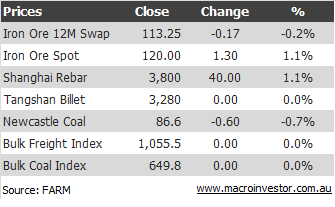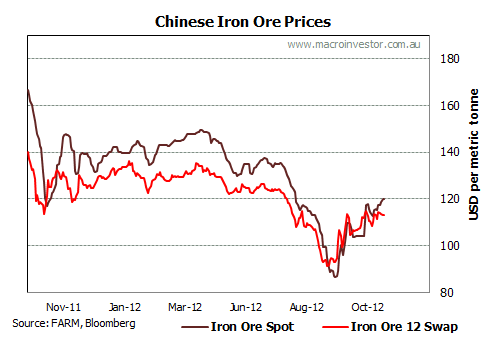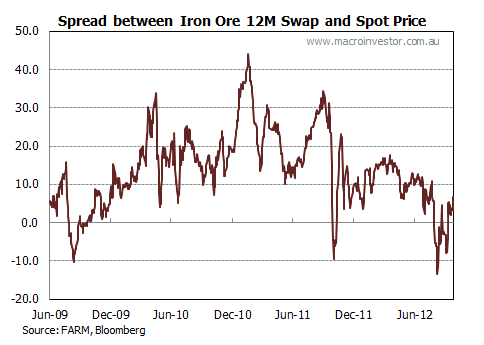
It’s an action replay of yesterday, the ore complex found some support in Chinese steel prices, a nice little rally in spot but no support coming though from swaps:

12 month swaps have gone nowhere now for over a month and it’s rather looking like we’ve found a new plateau. I’ve made up a chart of the recent history of the spread between spot and the 12m swap to fathom how wide it might go as some guide to where the coming spot price peak might be:

In the good old days there was a trading range between $5 and $30 for the spread. Since the late 2011 peak, it’s contracted to a range between $5 and $15 (with the odd breakout). Some of this can be accounted for by the lower overall pricing range, but not all. There has been a compression of the spread as the supply/demand equation has also shifted.
Right now it’s obviously at the low of its recent range at $7 so has scope to expand further and lift spot even if swaps remain stuck. But there are hints in the chart that a new range might form between $5 and $10, in which case the upside case for spot ore would be sub-$130. Still, as happened in the good old days, the spot price tends to lead the 12m swap so it’s also possible that it will drag it up.
Nothing definitive there, but it probably boosts the case that we are much closer to the top of the rally than we are the bottom given that if the recent ranges hold the upside for the spread is another $8 or so for spot.
In wider news, according to the FT, the ongoing rally is being driven, as we know, by Chinese steel mills restocking:
The recent rise in China’s construction and infrastructure investment activity has led to a rise in steel prices, fuelling a rebound in iron ore, which is a key ingredient for steel production.
Iron ore prices, which have been recovering since hitting a three-year low in September, on Thursday rose to $120.50 a tonne for material containing 62 per cent iron, according to Platts, the pricing agency.
Duncan Hobbs, metals analyst at Macquarie in London, said the destocking of raw materials among Chinese steel mills was over. With inventories at low levels, “the mills need to start buying the raw materials now to satisfy existing demand”, he said, adding that additional orders were also ticking up.
According to Macquarie’s latest monthly survey of Chinese steel mills, capacity utilisation in October rose for the first time since May as orders increased. The survey also showed that for the first time since April, the number of steel mills that said they would increase their purchases of iron ore surpassed that of mills that were intending to decrease their purchases of the raw material.
Goodo, but the real question is what happens when the restock is over? As we undershot we’ll now overshoot but then end-user demand will determine the price. I expect it will be sufficient to keep the price at $120 or below. The languishing price of coking coal supports this thesis.
In the meantime, whether it’s temporary or not, iron ore over $120 is a consideration for the RBA. We are two weeks from the next RBA meet and if the overshoot gets heated they might get spooked. However, I expect old heads will prevail.

